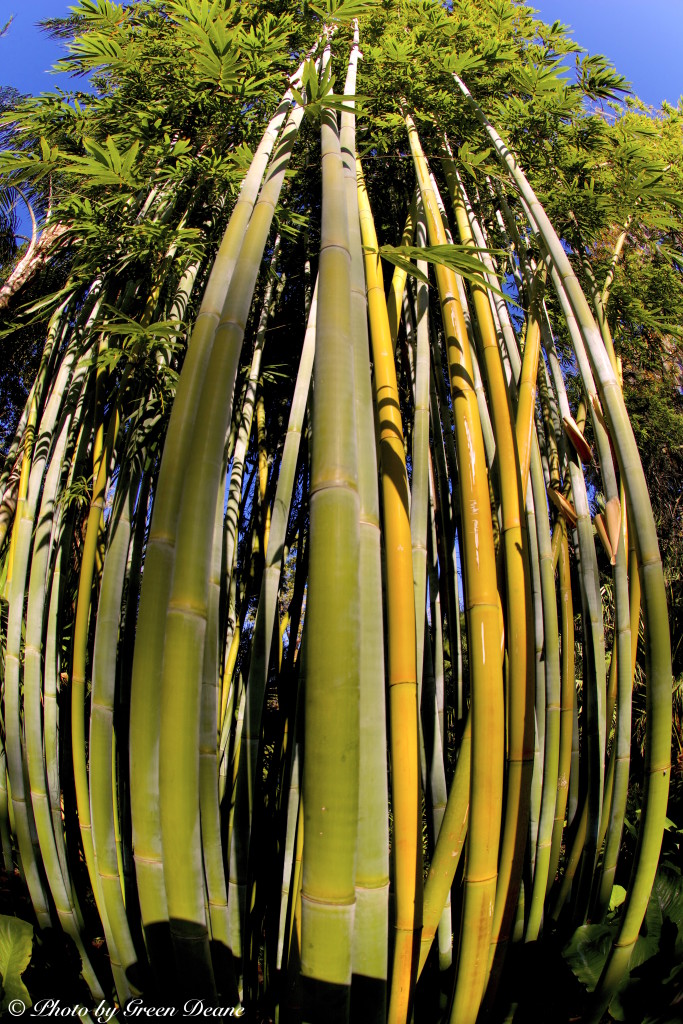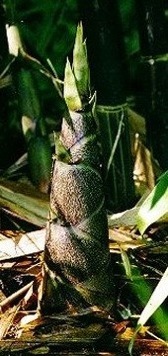Bambusa
Do not tell me you don’t live near bamboo. I grew up in 50-below-zero Maine and we had bamboo in front of the house for decades. In fact, the cooler the climate the bamboo comes from the better tasting are its shoots.
There are over 100 edible species of bamboo, and perhaps nearly all of the shoots of 1500-plus species are edible. No one really knows for sure. Most of them, even the edible ones, are bitter raw and that bitterness can vary. A few have some or no bitterness. Usually cooking the shoots in one or more changes of water reduces or gets rid of that bitterness. To prepare them remove the protective sheath, slice and boil, or chop and boil, or just boil. Incidentally, the size of the dentrocalamus shoot when it comes out of the ground will be the diameter it will be when full grown.
Actually there tends to be two kinds of bamboo, clumpers and runnners. Clumpers tend to be tropical and runners tend to be temperate. The temperate Phyllostachys bamboos are a leading source of shoots, among them Phyllostachys nuda, P. platyglossa, P. nidularia, P. hindsii, P. dulcis, and P. vivax. Other temperate bamboos are Semiarundinaria fastuosa and Qiongzhuea tumidissinoda. The most common shoots harvested for food in China are P. heterocycla f. pubescens, P. praecox, P. dulcis and P. iridescens.
The following may seem worth knowing but really isn’t: The seed grain of the flowering bamboo is also edible. Boil the seeds like rice or pulverize them, mix with water, and make into cakes. Why isn’t that good to know? The bamboo, depending on the species, flowers only once every 7 to 120 years.
The bamboo, which is really a grass, is so useful several books could be written about it and have. It’s food and building material. Without it several million people could not get by. It is probably only second to the palm in usefulness, or may even exceed palms. However, in many parts of the world it has become an invasive weed, Australia is a good example. It’s banned there in many places. The genus name, Bambusa, comes from the Malayan name for the plant.
Other Uses: Bamboo is used to build structures or to make containers (one section alone can carry water or serve as cooking pot. ) It also makes ladles, spoons, and various other cooking utensils. Bamboo is used to make tools, weapons, even a friction fire saw. You can make a strong bow by splitting the bamboo and putting several pieces together. Through technology, it is also made into plywood, composite beams and paper. You can also wrap food in the leaves.
When I shopped around for bamboo for my backyard (Phyllostachys viridis) I specifically bought one that was mild enough to eat raw, but I don’t make it a habit of it and here’s why. Most foraging books and various websites fail to mention that bamboo shoots have a cyanogenic glycoside, specifically taxiphyllin which is mostly responsible for the bitter taste. In your gut that can change to hydrogen cyanid also called prussic acid. Not good. However, taxiphyllin degrades readily in boiling water so I recommend boiling any bamboo shoots you try. And if you cannot boil the bitterness out, don’t eat it.
The only problem I had raising the bamboo is that it took a few years for the stand to get established. It spent a lot of time sending up underground runners, but when it did sprout, it grew incredibly fast. Indeed, it is the fastest growing renewable resource known to man. Some can grow four feet a day. Here are a few of the more desirable edible species:
Bambusa multiplex, one of the hardiest clumping bamboos often used for a hedge or windbreak. Bambusa oldhamii , another clumping bamboo with straight stems, also used for hedges and windbreaks. Bambusa tuidoides ‘Ventricosa’ also called Buddha’s Belly. It has pot belly type internodes. It’s a clumping bamboo or can be grown in a pot.
Bambusa Vuigaris ‘Vittata’ the Painted Bamboo, has golden stems with green stripes that vary in width. It can be grown in a pot indoors. Phyllostachys edulis, Moso, the largest of the hardy bamboos. It makes a hedge or windbreak and is used in bamboo crafts. Phyllostachys vivax, has stems with thin walls and white powdery bands below the nodes. It is cold hardy. Phyllostachys atrovaginata, edible raw, little bite, cold hardy. Makes a good hedge or windbreak. Phyllostachys nidularia, also edible raw, makes a good hedge or windbreak, cold hardy. Phyllostachys rubromarginata, high cold tolerance, good eating quality, can be used for hedge or windbreak or in bamboo craft.
Lastly, bamboo is tough. One stand was at ground zero at the 1945 Herioshima atomic blast. Within days it sent up new shoots.
With 70 genera and 1,575 species it is difficult to identify. Stems have nodes that are hollow in between. Growth is columnar. No branches first year, can grow up to 39 inches a day.
Pictured above is “Emerald Bamboo” or Bambusa textilis mutabilis, growing happily in Leu Gardens in Orlando, Florida.
Green Deane’s “Itemized” Plant Profile
TIME OF YEAR:
Seasonal and year round depending upon climate
ENVIRONMENT:
Bamboo can be found from cold mountains to hot deserts.
METHOD OF PREPARATION:
Many bamboo shoots have to be cooked to rid them of cyanide. The sap and shoots can be fermented. Pith of young shoots can be pickled. The seeds are edible but some bamboos only flower once every 120 years.



